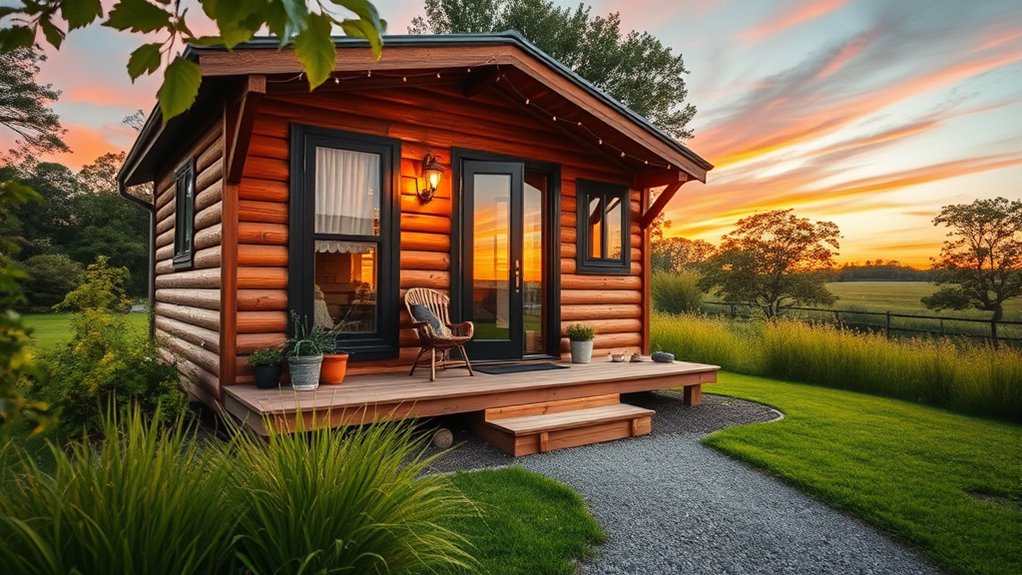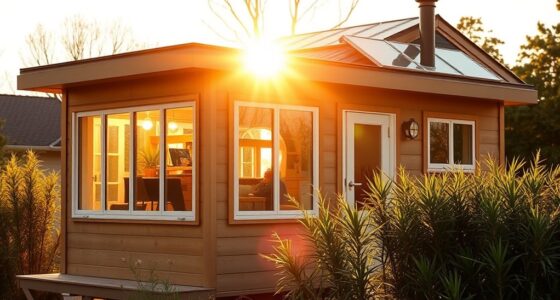Did you know that many tiny house hosts overlook the hidden costs that can eat into their profits? While setting a competitive nightly rate is essential, understanding how expenses like cleaning, maintenance, and platform fees impact your overall earnings is just as important. Without a clear profit breakdown, you might be surprised by how little you actually keep after each guest. Curious to find out how to maximize your tiny house’s income?
Key Takeaways
- Calculate total income by multiplying nightly rate by occupancy rate and rental days.
- Deduct expenses such as maintenance, cleaning, supplies, and platform fees for net profit.
- Consider additional costs like utilities, insurance, and property upgrades to accurately assess profitability.
- Optimize pricing and amenities to attract more guests and increase occupancy, boosting overall earnings.
- Regularly track and analyze financial data to adjust strategies for maximizing rental income.

Renting out your tiny house on Airbnb can be a lucrative way to earn extra income while sharing your unique space with travelers. It’s crucial to prioritize guest communication because clear, prompt, and friendly interactions can lead to positive reviews, repeat bookings, and increased earnings. When guests reach out with questions or concerns, respond quickly and professionally, setting a tone of trust and hospitality. This not only enhances their experience but also minimizes misunderstandings that could lead to negative reviews or cancellations. Additionally, maintaining open lines of communication helps you stay informed about your guests’ needs, allowing you to address issues proactively.
Prioritize clear, prompt communication to enhance guest experience and encourage positive reviews on Airbnb.
Property maintenance is another critical aspect of successfully renting out your tiny house. Regular upkeep ensures your space remains attractive and functional, which directly impacts your income potential. You should perform routine inspections, checking for any damages, leaks, or wear and tear that might affect the guest experience. Keeping everything in top shape reduces the likelihood of emergency repairs during a guest’s stay, saving you money and stress. Simple tasks like cleaning, fixing broken fixtures, and ensuring appliances work properly are essential steps. Investing in quality maintenance also demonstrates your commitment to providing a comfortable stay, encouraging positive reviews and higher occupancy rates.
When it comes to pricing your tiny house, consider your ongoing property maintenance costs and the level of guest communication you can provide. Setting a competitive nightly rate that reflects your property’s condition and location will attract more bookings. Offering amenities such as fast Wi-Fi, clean linens, and well-stocked supplies makes your listing stand out and justifies a higher price point. Be transparent about your policies regarding property maintenance and guest communication in your listing. For example, informing guests about response times or how you handle maintenance issues reassures them and sets clear expectations.
Additionally, exploring online resources for hosting tips and local regulations can help you stay compliant and optimize your rental strategy.
In terms of managing your income, track your expenses carefully. Property maintenance costs, cleaning fees, and any supplies you purchase all cut into your profit, so keeping detailed records helps you understand your actual earnings. Additionally, consider setting aside a portion of your income for future repairs or upgrades, ensuring your tiny house remains a desirable destination for travelers. By balancing excellent guest communication with diligent property maintenance, you maximize your rental income while creating a memorable experience for your guests. This approach ultimately increases your tiny house’s earning potential and helps you sustain a profitable and enjoyable hosting adventure.
Conclusion
Think of your tiny house as a well-tuned instrument, where each string—pricing, maintenance, and guest service—plays a crucial role. When you balance these elements, your rental melody attracts guests and fills your calendar. I once knew a host who kept her rates competitive and responded quickly—her bookings soared like a symphony reaching a crescendo. With attention and care, your tiny house can turn every stay into a harmonious success, maximizing your profit and guest satisfaction.
Hi, I’m Emma. I’m the Editor in Chief of Tiny House 43, a blog all about tiny houses. While tree houses are often associated with childhood, they can be the perfect adult retreat. They offer a cozy space to relax and unwind, surrounded by nature. And since they’re typically built on stilts or raised platforms, they offer stunning views that traditional homes simply can’t match. If you’re looking for a unique and romantic getaway, a tree house tiny house might just be the perfect option.










